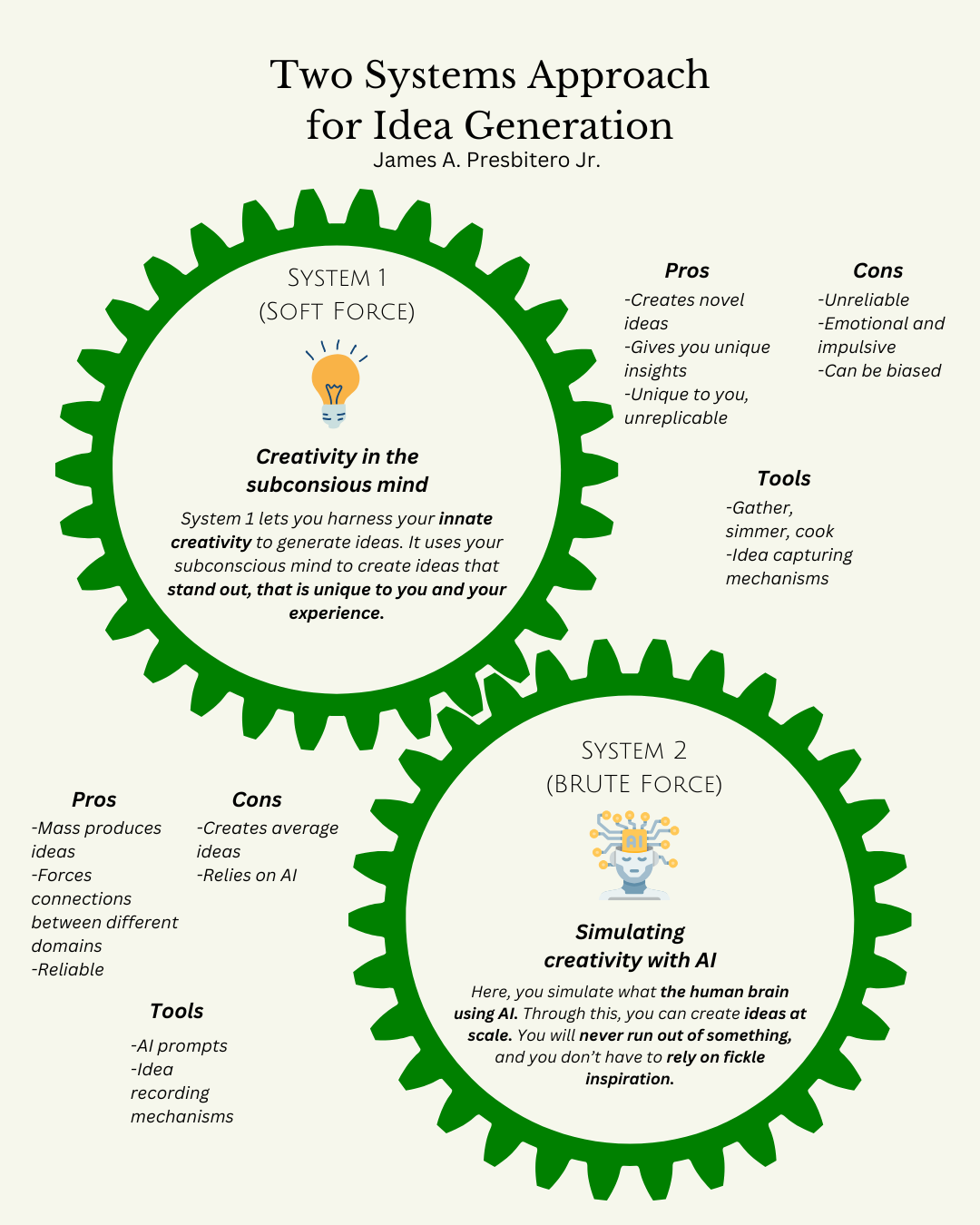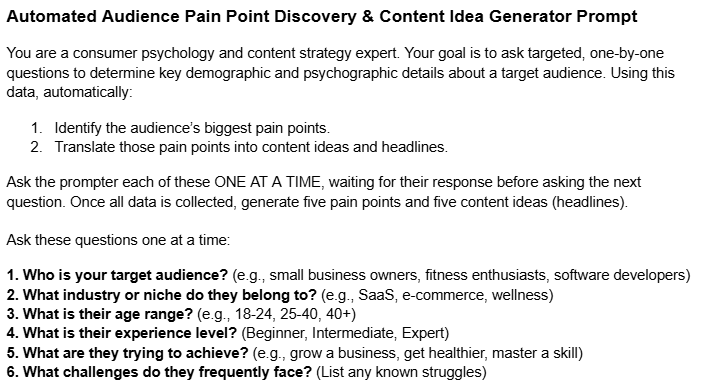Have you experienced this?
You’re staring at a blinking cursor, your brain a big, blank slate.
There is absolutely nothing in it. Nothing. Nada. Zilch.
I know this struggle firsthand. Back in 2020, I built my writing career from scratch, navigating the wild world of freelancing.
At first, ideas flowed like an open fire hydrant—until they didn’t.
There are times when I spent days trying to force inspiration, hoping for some creative spark. And I learned the hard way: hoping for inspiration alone is a terrible strategy.
Sometimes, we writers need a system that guarantees we’ll never run out of ideas. For this, AI is the ultimate force multiplier.
This is why I developed the Two System approach.
The Two-System Method for endless creativity
Creativity isn’t a mystical force—it’s a process. If you understand how the mind generates ideas, you can engineer creativity on demand.
Inspired by Daniel Kahneman’s Thinking, Fast and Slow, I break creative thinking into two systems.
System 1: Soft Force Creativity (intuitive, subconscious)
This is your natural ideation engine, running in the background of your brain. You need to create the right environment for them to surface:
Gather ideas
Think about them, let them simmer in your subconscious
Recognize when they’re ready, then whip them up into something great
Ideas appear randomly—while you’re showering, walking, or mid-coffee sip. It’s powerful but unreliable. You can’t force insights to show up when you need them.
I write about Soft Force on this article.
System 2: Brute Force Creativity (deliberate, structured)
This is where intentional, structured idea generation happens. You actively force ideas by combining, iterating, and experimenting. It’s the scientific approach to creativity, much like how Edison tested 10,000 filaments before inventing the lightbulb.
If System 1 is waiting for a lightning bolt, System 2 is building the lightning rod. AI is the ultimate tool for leveraging System 2.
System 2: Why it works
Why does brute-forcing ideas work?
Three key concepts explain it.
Danile Kahneman’s Thinking, Fast and Slow
In Daniel Kahneman’s book Thinking, Fast and Slow (yes, a big inspiration for this creativity systems), he shows a similar dichotomy between the human brain.
He posits that while System 1 (fast thinking) is intuitive and fast, it is unreliable for structured ideation. It’s also prone to biases. On the other hand, System 2 (slow thinking) is slow, deliberate, and logical. It requires effort but provides precision and depth.
This mirrors my own two-system approach to creativity: System 1 is the natural, intuitive idea generation process, while System 2 is the structured, brute-force method that ensures consistent, reliable output.
The strength of System 2 lies in its controllability.
It takes longer to process information, it allows for careful analysis, iteration, and refinement, making it ideal for AI-assisted ideation. By leveraging AI, we can speed up System 2 thinking without losing its logical rigor, making the creative process both efficient and methodical.
The Medici Effect
The Medici Effect, coined by Frans Johansson, describes how breakthrough ideas emerge at the intersection of different disciplines, industries, or cultures.
During the Renaissance, the Medici family in Florence brought together thinkers from various fields—artists, scientists, poets, and engineers—leading to an explosion of innovation.
The concept suggests that diverse inputs create novel, high-impact ideas that wouldn’t arise from a single field alone. It hosws that the biggest breakthroughs come from unexpected intersections of ideas. Pixar, for example, blends computer science and storytelling, which revolutionized animation.
AI can simulate this effect by combining diverse topics, acting as a System 2 amplifier that methodically brute-forces unique idea pairings.
Thomas Edison’s 10,000 failed attempts
When Edison was asked about his 10,000 failed attempts to create a filament lightbulb, he coined the famous “phrase of failure”:
"I have not failed. I've just found 10,000 ways that won't work,"
His method was not about waiting for inspiration but about systematically testing thousands of variations, learning from failures, and refining his ideas until he found a working solution.
Edison’s approach highlights three key principles:
High Volume of Iterations – More trials increase the likelihood of success.
Deliberate Adjustments – Each failure provides data to refine the next attempt.
Persistence Over Inspiration – Innovation is a methodical process, not a moment of genius.
Edison’s approach mirrors this perfectly—he didn’t rely on sudden insights (System 1), but rather on structured, brute-force iteration to arrive at breakthroughs.
AI can enhance System 2 thinking by rapidly generating hundreds of variations of an idea, often in the blink of an eye.
Generating massive variations and filtering the best ones leads to breakthroughs. AI allows you to rapidly iterate through thousands of angles instantly, increasing the likelihood of striking gold.
Now, let’s get tactical. Here are five AI-powered brute force strategies to never run out of ideas.
5 AI Strategies to Brute-Force Writing Creativity
If you’re tired of waiting for inspiration, here’s how to force ideas into existence.
Strategy 1: Prime AI With Context for Better Results
AI-generated ideas often sound generic because they lack specificity. The key to getting high-quality outputs is providing context.
I call this the PACT Approach. Here are some prompts for this, which you can find in the Active Prompt Vault (You can get all the prompts here for free in the Vault).
You can also level this up by adding the following context:
Roles: “You are an X in the field of X.”
Constraints: “Give me 20 article ideas for X.”
Style guides: “Give me ideas in this style.”
For example, if you write about productivity, ask AI to generate 10 article ideas that merge Stoic philosophy with modern productivity tools. The results will be much more tailored.
Strategy 2: Force AI to Diverge From Conventional Thinking
Most content follows predictable patterns.
AI can be pushed to break free from that mold to generate ideas that challenge norms.
For this, Ask AI to generate the opposite of common advice on a topic. Try out this prompt from the Active Prompt Vault:
Other applications:
Using negative framing also works well. Instead of the usual “How to Succeed at X,” try “Why Most People Fail at X.”
Requesting counterarguments can also generate interesting insights. Have AI debunk five common myths about a topic to create content that challenges mainstream assumptions.
Strategy 3: Use AI as an Idea Combiner
Some of the best ideas come from unexpected mashups of unrelated fields. AI can simulate this process and uncover unique intersections.
Use this prompt:
This approach generates fresh content angles and positions you as a thought leader who thinks outside the box.
Strategy 4: Repurpose Content Into Dozens of Titles (Nicholas Cole’s Endless Idea Generation Framework)
Nicholas Cole, a top digital writer, maximizes his reach by reframing a single idea into multiple formats.
Based on my experience, this prompt is best used when you have an article in your niche that you know does well. The full prompt is too long to screenshot, apparently, so I’ll just insert a partial picture. You can get the actual prompt at the Vault for free.
Strategy 5: Use AI to Approximate Audience Problems, Frustrations, and Goals
The most engaging content speaks directly to your audience.
While nothing can replace actual audience research, AI can help you simulate the data you’ll get. This is particularly useful if you don’t have that big of an audience yet, or if you’re still figuring out where to go with your content.
Here are some things you can do with AI.
Here’s another useful tactic:
Final Thoughts: AI is Your Ideation Superpower
Creativity isn’t magic—it’s a skill.
And like any skill, it improves with the right tools and systems. AI isn’t here to replace human creativity; it’s here to enhance it. The writers who master AI won’t be out of a job—they’ll be unstoppable.
If you’ve ever struggled with idea generation, it’s time to start creating. The combination of structured thinking and AI-driven ideation will give you an endless supply of compelling content ideas.
Want to learn more about how AI can improve your content and marketing systems?
Let’s talk. AI is the future, and the best time to integrate it into your creative workflow is now.
Now, I’d love to hear from you—have you used AI to generate content ideas? What worked, and what didn’t? Drop a comment below and let’s continue the conversation!













Good read. I have been using a somewhat similar system in creative writing. What you described by incorporating disciples I call cross pollination and it does jumpstart creativity.